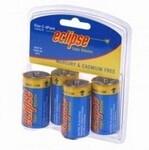I've never used these batteries, but the price seems to be worth a try
USB Rechargeable C Lithium Battery 1.5V 2-Pack
Why pay $39.99
ONLY $19.99
SAVE $20.00!
https://www.marine-deals.co.nz/batteries/usb-rechargeable-c-…
USB Rechargeable 9V Lithium Battery
Why pay $27.99
ONLY $7.99
SAVE $20.00!
https://www.marine-deals.co.nz/batteries/usb-rechargeable-9v…
USB Rechargeable AAA Lithium Battery 1.5V 4-pack
Why pay $39.99
ONLY $19.99
SAVE $20.00!
https://www.marine-deals.co.nz/batteries/usb-rechargeable-aa…
USB Rechargeable AA Lithium Battery 1.5V 4-Pack
Why pay $39.99
ONLY $19.99
SAVE $20.00!
https://www.marine-deals.co.nz/batteries/usb-rechargeable-aa…
USB Rechargeable D Lithium Battery 2-Pack
Why pay $39.99
ONLY $19.99
SAVE $20.00!
https://www.marine-deals.co.nz/batteries/usb-rechargeable-d-…


I never knew such a thing existed as a USB rechargable battery! It looks like they sacrifice a little capacity for the inbuilt charging mechanism but I'm sorely tempted to give them a go. Off to look for some reviews. Thanks OP.